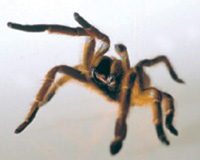A 60_Acre Web of Mystery
Millions of Tiny Spiders Spin Mystery in a British Columbia Clover FieldExperience is never limited, and it is never complete; it is an immense sensibility, a kind of huge spider-web of the finest silken threads suspended in the chamber of consciousness, and catching every air-borne particle in its tissue. - Henry James
A warning: If the thought of tens of millions of tiny spiders spinning a web 24 hectares - 60 acres - in size and crawling all over it scares the wits out of you, you might want to tread carefully over the following. Because that's exactly what happened last month on a farmer's field near McBride, about 220 kilometres east of Prince George. For reasons that area scientists don't really understand, millions and millions of tiny black spiders called Halorates ksenius - they have no common name - became trapped in Russell Jervis' clover field and started spinning webs. Halorates ksenius is not a big spider. "One could fit comfortably on a Smartie with plenty of room to spare," says Brian Thair, a cell biologist at the College of New Caledonia in Prince George. (Or to put it another way, it's about as big as a capital "O" printed on this page.) A typical barbwire fence on wood posts surrounded the field about six kilometres east of McBride in the Robson Valley. Thair said it looked like the whole area was covered with an opaque, white plastic grocery store bag. The thin, elastic coasting was not soft and fluffy like webs built by individual spiders. There were about two spiders per square centimetre laying the silk, which first appeared in early October. Thair said the web showed great tensile strength - enough to put a handful of coins on it without them falling through. There were "in the order of tens of millions of spiders running frantically back and forth," but they weren't interacting with each other. It's just because so many of them were in the field that the web grew and grew until at its largest, 60 acres, it was as big as the triangle-shaped field it covered. Thair had never seen anything like it before. "It was astounding to see," he said. "I couldn't believe my eyes. From two kilometres away it looked like a sheet of wet aluminium. It was the size of several city blocks. I have never in my 30 years as a biologist seen anything like this, in terms of quantity of spiders and quantity of web. Nothing even remotely approaching this." Most of the web is gone now. Storms have ripped it apart. But during October and into early November, Thair says, it was home to possibly hundreds of millions of tiny black spiders that just kept spinning and reproducing. That caused the web to grow so large depends on whom you ask. Thair speculates that perhaps because of some unusual weather conditions in late summer and early fall, the spiders were unable to disperse. Normally, when young spiders reach reproductive age, they spin a thread of web - a silk parachute - which is then caught by a breeze and lifts them into the air. It's called "ballooning." The wind carries the thread, with the spider attached to it, for some distance before dropping it. Where the spider lands is where it makes its home. But Thair guesses that because of too much rain or an absence of wind, the spiders in Jervis' field were unable to balloon, so they stayed where they were. Then they laid eggs, which turned into more spiders, which laid eggs and became yet more spiders. Added to that was the fact that for some reason - again Thair doesn't know what it was - the adult spiders failed to die, so they kept on reproducing too. And on and on it went. Since the spiders didn't seem to care if an occasional insect stumbled into their construction, Thair doesn't think it was built for trapping purposes. He suggests the spiders encountered an enormous quantity of high quality, nutritious prey to be able to accomplish this feat. But he's also heard other suggestions. "Some people have said, 'oh yes, well it's a trampoline for aliens,'" Thair joked. "Or maybe it was an effort collectively by these spiders to try and catch a sheep." Robb Bennett, an entomologist with the BC Ministry of Forests disagrees. He says the "sheet of gossamer" was likely millions and millions of drag lines the spiders produced prior to dispersing. Drag lines, he says, are anchors that spiders produce routinely to keep them connected with the ground. Bennett says these spiders - what he calls "LBJs for Little Brown Jobs" - and others very like them, live commonly in the north and probably emerged from the ground looking for the highest points in the field from which to disperse.
However, because no one who saw the web saw any spiders dispersing, he can't say for sure that a dispersal took place. Nor has Bennett ever heard of so many spiders behaving this way so far north. He's never seen the phenomenon himself, but does have a photo of a similar event in the 1990s in Louisiana. Consequently, he speculates that it may have something to do with warm temperatures. Whatever the cause, Bennett agrees with Thair that it was extraordinary. Jervis, who has owned the land for 60 years, has never seen anything like it on his farm. "The first people who saw it [in early October] thought it was frost," he said. "Then they realised it couldn't be frost because there wasn't frost anywhere else. It just kept growing and growing. Like everybody else, I'd never seen anything like it before." Jervis plowed the field early this year, which meant that in addition to the stubble a few young plants were starting to sprout. They were covered in thick cobwebs. So were the fenceposts surrounding the field. So thick, says Thair, that he had to use a hunting knife to cut pieces of it away. (Comparatively, a spider's web is stronger than steel.) The field itself was translucent, covered with just a thin layer of web that broke if you walked on it. But on the fenceposts, where it was thickest, it was like sheets of grocery store plastic, says Thair. "You know how when you stretch a piece of plastic tight over a bowl, your fingers bounce off it? That's what it felt like." Matthew Wheeler, a freelance photographer who lives in McBride, spent 5 hours one day taking pictures of the web and the spiders scurrying all over it. "The top of every plant and willow bush and fencepost was completely capped with this white sheet," he says. "And the whole field was undulating in a delicate way in the breeze." But if that sounds vaguely beautiful, there was a point when Wheeler said it was anything but. "There were spiders crawling all over my trousers and jacket, and they had started to spin webs over my camera bag. So I started to think about all the poison represented by all those millions and millions of spiders out there, and I started to wonder if I was being really stupid standing there." He was never bitten, but the sight of thousands of spiders "seething" over a fencepost is one he'll never forget. "I've photographed all kinds of things in astronomy and nature, but this was in a class of its own." Could it happen again next year? Thair doesn't know how the spiders were able to survive so close together for so long. It takes a lot of energy and protein to spin a web, so the spiders must have had a ready food source while they were trapped in the field. Thair doesn't know what it was nor does he know if they laid eggs which will survive over the winter. But he intends to examine the field more closely in coming weeks and months to find out. Thair has no patience with anyone who might be grossed out by the idea of so many spiders. "People are taught to be afraid of spiders," he says. "That's disgusting. Anyone who was afraid of spiders wouldn't have gone near this, and they would have missed something extraordinary. Adults inadvertently destroy their children's interest in science and nature by telling them to be afraid of spiders. They should stop." Source: crawford2000.co.uk Friday 29 November 2002 and cbc.ca/stories 27 Nov 2002 photos from cbc.ca/news and taken by artist/photographer Matthew Wheeler See also:
Spiders Aren't the Only Source of Prodigious Webs...
Caterpillars unleashed... Source: eatliver.com
Spider Attacks in MerseysideSpiders have transparent blood.
The Dysdera Crocata spider Merseyside is being hit by a spate of spider attacks. This 6-eyed spider normally eats woodlouse but now has a taste for human flesh. Experts say the pain from its double-pricked sting can last for 24 hours. Paul Rowley, of Liverpool's School of Tropical Medicine, said: "There have been a number of cases of spiders biting people in Merseyside." The attacks have centered on Liverpool and the Wirral, reports The Guardian. The spider, dysdera crocata, normally lives under stones or in rotting wood, but they sometimes venture into homes - especially those with damp problems. Source: ananova.com Friday 5 October 2001
Canadian ImportBut can I believe him?
Source: A pot of dirt on my kitchen windowsill now otherwise devoid of life.
Tesco Uses Killer SpidersThe average human eats 8 spiders in his/her lifetime while sleeping.
Deadly ... Black Widow spider by Jamie Pyatt Tesco yesterday admitted using deadly Black Widow spiders to kill off insects in its bunches of grapes. The shock revelation comes after three women found Black Widows — two of them ALIVE — in fruit they bought at different Tesco stores. The spiders, which have red markings on their backs, were introduced to Tesco vineyards in California as an alternative to pesticide, following customer demand for "natural" food. But the grapes are supposed to be hand-checked before being exported. Tesco spokesman Greg Sage said last night: “We use natural predators on grapes because they prevent insects from puncturing the grapes. The spiders are very effective. All I can do is apologise for any distress this may have caused. We’ve spoken to our suppliers to ensure that the checking process is as good as it can be. The fact that the spiders are alive is evidence that we’re not using pesticides — because if we were they’d be dead.” A Foods Standard Agency spokesman said: “The local authority has powers to take action.” London-based spider expert Paul Hillyard said: “Black Widows can cause considerable damage with a bite which is potentially lethal.”
Edward Cooper, 10, and sister Sophie, 5, whose mum Linda, 39,
Steph Thorneycroft, 43, of Wimborne, Dorset, who found a Black Widow
Lindy and Jaime Bolzern stare at the dead Black Widow Source: thesun.co.uk Wednesday 11 December 2002
Stalking Spidersby Sy Montgomery Tarantulas reveal intriguing mammal-like behaviours, says a scientist who cares enough to study them (not to mention keep 500 of them alive in his lab)...
French Guiana, best known for the notorious Devil’s Island penal colony, is the tarantula capital of the world. The size of Indiana, this South American protectorate hosts at least a dozen species, including the world’s largest, Theraphosa blondi, the goliath birdeater. To Marshall, an assistant professor of biology at Hiram College in Ohio, the jungle here is a little bit of heaven. Within minutes, the 45-year-old arachnologist is lying blissfully on his belly, poking a twig down a foot-long tunnel. "Come out!" he calls into the tunnel. "I want to meet you!" Marshall’s freckled face is inches from a fist-size hole inhabited by a quarter-pound tarantula. Make that an angry quarter-pound tarantula. With a walnut-size abdomen and a head as large as a 50-cent piece, the goliath birdeater has a 12-inch-wide leg span that could cover your face. Or in this case, Marshall’s face. "Oh! Now she’s kicking!" Marshall says as he shines his headlamp into the hole. "She might be kicking hairs! Can you hear her hissing?" A rasping sound comes from the hole. But Marshall holds his ground. A few seconds later, he wishes he hadn’t. His face is itching and burning. The goliath birdeater has used her hind legs to kick microscopically barbed hairs off her abdomen. They ended up in Marshall’s face, irritating his skin, eyes, and nose. Despite its size, the goliath isn’t deadly to humans, but its defense mechanisms are more than unpleasant. For Marshall, a face full of tarantula hair is part of the job. And before long he’s back looking into the same hole. So little is known about the goliath that despite its name (bestowed because an early specimen was recorded feeding on a songbird), nobody actually knows what it normally eats. Only twice has the species been seen making a kill in the wild - once an earthworm, another time a caecilian, an amphibian. To Marshall, such ignorance is indicative of what’s wrong with arachnology. "Here we have the biggest of something in the world, and nobody studies it!" he says. Despite the growing number of humans who seem to enjoy keeping tarantulas as pets, the spiders are mostly a mystery. Marshall is one of only a dozen arachnologists worldwide specialising in them - and the only scientist who runs a lab full of tarantulas gathered from around the globe. He is also the only scientist who has written a popular book about the creatures: Tarantulas and Other Arachnids: A Complete Pet Owner’s Manual. "It’s a pretty huge unfilled niche that he’s in," says Jonathan Coddington, an arachnologist at the Smithsonian Institution. Scientists have long dismissed tarantulas as too primitive to exhibit interesting behaviour. Arising 150 million years ago from a smaller, hairy ancestor, the creatures retain such primitive characteristics as fangs that move up and down instead of sideways, and they don’t weave webs. In his Biology of Spiders (1982 edition), German arachnologist Ranier Foelix barely mentions tarantulas. "Not long ago," wrote English biologist T H Savory of Malvern College, "the spiders were the most neglected of the most interesting animals." Another reason for the neglect has been the tarantulas themselves. They are more difficult to study than common garden spiders. They tend to live deep in sometimes-twisting holes in the sweaty tropics, they’re too big to fit under a microscope, and females can live for 30 years, making for long time frames between generations and slow captive breeding. Marshall, son of the late actor E G Marshall, is changing that - and at the same time, he hopes, the tarantula’s image as the bloodthirsty villain of grade B horror films. He says part of his job is to "de-demonise these spiders. They don’t have a bloodlust to bite people. They’re just little fuzzy creatures, and if you handle them correctly, they’re harmless. I just basically make them seem like interesting animals rather than some horrible creature." His studies have revealed a surprising aspect of the breed: tarantulas share many behaviours with mammals. Like most spiders, they seem to be solitary cannibals, so intolerant of company that some females snack on their suitors. But others tenderly care for their young, and tarantula families sometimes share food. Mother tarantulas are known to go without eating so that their offspring can eat. Muses Marshall, "Who’d have thought that the world’s scariest spider would have family values?" Still, spiders are not hamsters, and on the door of his lab at Hiram College’s J H Barrow Field Station, 20 miles southeast of Cleveland, Marshall has posted rules for visitors: "Do not open or move any container. Many tarantula species are very fast and aggressive and will bite. Accidentally releasing a tarantula could end badly for both you and the spider. Please don’t take any unsupervised tours!" But Marshall is happy to supervise visits and proudly declares, "This is the only comparative tarantula lab that is global in reach." To prove it, he points out a silver and black Heteroscodra maculata, originally from Cameroon, that resides in a wide-mouthed plastic coffee jug marked "Use Extreme Caution" and "Potentially Dangerous." In a glass jar that once held 155 pieces of watermelon-flavored taffy, he has restrained an iridescent Avicularia metallica, collected off a tree at a rest stop along Route 1 outside Cayenne, French Guiana. There are Tanzanian chestnut tarantulas in plastic food tubs, and baby blonde-leg tarantulas in potato-salad deli cups. Marshall says his spiders are comfortable. Few tarantulas roam widely, preferring to live out their lives almost entirely within inches of their burrows. "You can say tarantulas are agoraphobics," he said. "See how they live in the wild: one foot in a tidy, snug hole. Tarantulas just do their thing, whether they’re in a plastic container from Wal-Mart or on the side of a tree in South America." All in all, there are about 500 live tarantulas in a room the size of a spacious kitchen. Many of them were originally housed at Marshall’s house, where he kept "a big collection" of tarantulas for a number of years. How big? "Hundreds," he answers. "Hundreds. Hundreds." During his postdoctoral years at Miami University in Ohio, he had a 2-bedroom apartment - "one people bedroom, one tarantula bedroom." He had already married a fellow arachnologist, Maggie Hodge, who clearly did not mind spiders. She did not, however, like the rattlesnake that was living in his closet when they met at the University of Cincinnati. Marshall’s course in life was set in his teens - possibly from the moment he saw his first tarantula in a tank on the desk of a US Park Service ranger in New Mexico. "I saw that and thought it was the most amazing thing," says Marshall. The large spiders soon joined the menagerie of exotic poultry, turtles, snakes, monitor lizards, and falcons he kept in sheds behind his parents’ house in Mount Kisco, New York, and in their labyrinthine basement. When he was an undergrad at Bard College in New York, tarantulas shared his dorm room with a hawk, ferrets, a monitor lizard, and a ball python. (The dean of students made him move his scorpions to the biology department.) "I think of myself as a xenophile," Marshall says. "I was drawn to things that are different." And what could possibly be more different than a tarantula - a big, hairy spider who wears her skeleton on the outside, who smells and tastes with her feet, and whose fanged, eye-covered head is also endowed with eight legs, two arms, and a sucking stomach?
When threatened, the Usambara orange tarantula can get very aggressive. Tarantulas are far less dangerous to humans than other spiders, such as the black widow. No tarantula’s venom is toxic enough to kill a human, and they seldom bite. But they shed their hairs - projections on the exoskeleton called setae. Although tarantula hobbyists have endured the hairs for decades, the details of their use for defense were not studied until the 1970s, when researchers discovered that some of them seem to be designed to defend against a single species. The hairs of the Mexican blonde tarantula, for instance, are adapted to irritate only the nasal passages of the grasshopper mouse - a job they do so well that they can kill the rodent. So far, seven structurally distinct types of defensive hairs have been recognised; Marshall discovered one of those and found new uses for several others. Some species, for example, shed clouds of golden hairs from their mouths; others shed from their bellies. One sheds hairs onto egg sacs to protect its young from predators and parasites. The goliath birdeater, Marshall found, uses its hairs to create a special silken mat on which it lies upside down when molting. But perhaps the most original use to which tarantulas have put their copious hair - including the goliath birdeater - is to make noise. The goliath makes the loudest sound of any spider - a hiss audible from 10 feet away and designed to scare off predators. Marshall discovered that the noise comes from a scrubbing motion the tarantula makes with the two food-handling arms at the front of its head and the first two pairs of its walking legs. The noise sounds like strips of Velcro being ripped apart and is created in much the same manner - by entangling the microscopic hooks of one set of leg hairs with the filaments of another and pulling them away from each other. Marshall’s discovery was confirmed in a series of ingenious experiments. In one, his collaborator Ellen Thoms at the Cincinnati Zoo spray-painted molted tarantula exoskeletons gold to prepare them for study under an electron microscope, which revealed the fine structures of the hooks and filaments. In another experiment, Marshall shaved the legs of one of the giant arachnids. He knocked out his subject with CO2, removed some hairs with a razor, revived the beast, riled him, then listened for hissing. Then he shaved a little more. When the hissing stopped, he knew he had hit the right hairs. The experiments went well beyond understanding the hairs themselves. They show that tarantulas evolved profoundly and rapidly to adapt to ecological challenges - unlike such living fossils as horseshoe crabs, which have remained unchanged for millions of years. The great challenge for tarantulas was probably the sudden appearance of burrow-dwelling, spider-hunting mammals, the forerunners of today’s skunks and possums. "Some tarantula ancestor evolved the urticating hairs, and it just went woof! It just took over," Marshall says. "It’s one of the greatest evolutionary tales you can tell." Urticating hairs - those that provoke itching - evolved only in New World tarantulas, which reside in areas ranging from the South American tropics to as far north as Rolla, Missouri. About 500 of Earth’s 850 tarantula species live in the Americas. Of those, 460 have urticating hairs. In the tropics, the hairs are not the perfect defense against the coatimundi, a long-snouted relative of the raccoon that can move fast enough to avoid the hairs. Wasps are another problem for tarantulas. Several varieties paralyse tarantulas with their sting and then lay eggs in the spider’s abdomen. When the eggs hatch, the paralysed spider is eaten alive by wasp larvae. Even the goliath birdeater is not immune. The particular species of wasp that feeds on the goliath is the size of a sparrow. Elsewhere, tarantulas without hairy weapons have had to make do with aggression. Marshall says tarantulas from Asia, Europe, Australia, and Africa can seem nasty-tempered. He tells a story about one tarantula in Australia that reared up and, waving its legs and gnashing its fangs, chased away a dog. Although a tarantula can’t kill humans, "the venom of Australian tarantulas is deadly to dogs," Marshall says. "It’s one of those flukes of venom." When it’s feeding time at the spider lab, Marshall uses tweezers to seize a cricket hopping around the food terrarium, opens a tarantula container, and drops in the insect. The spider gravitates to it like metal to a magnet, then begins to chew and suck its food. Although tarantulas are such eager eaters that they often eat each other, Marshall found that a female Tanzanian chestnut tarantula will put down its freshly killed prey and allow its young to feed instead. "They appear to sacrifice for their offspring," Marshall says. "They defer eating themselves. They become anorexic. While the babies get fat, the mother shrinks." What’s more, some tarantula young appear to cooperate with one another at mealtime. With most spider species, the young push their siblings away from food. But in the Cameroon red tarantulas that Marshall describes in a forthcoming paper, spiderlings not only feed side by side without aggression but with their legs woven together. When Marshall saw this he realised: "They are huddle-feeding together. This is cooperation!" A Memphis Zoo colleague, Steven Reichling, recorded a similarly striking behaviour in a related species of African baboon spider, Hysterocrates crassipes. He noted that a female spider faced with another mother’s hungry babies did not try to kill or injure them - even when they annoyingly crawled up her legs and tried to eat her meal. In the company of suitors, females of this species also exhibited remarkable restraint: a male survived in a female’s enclosure for two months without being cannibalised and finally was removed without incident. Even more surprising, in a presentation at the Ohio Academy of Science two years ago, two of Marshall’s undergraduate students demonstrated that Indian ornamental tarantulas - fast, high-strung spiders with bright black-and-yellow markings on their forelegs - usually choose to live with a sibling. Melissa Varrecchia and Barbara Vasquez offered twenty 11-month-old tarantulas a choice of retreats: a tube in which a sibling had spun silk or an identical empty one. Fourteen chose their sibling’s tube. Under Marshall’s tutelage, another undergraduate, Amanda Wiegand, discovered that an inch-long East African tarantula performs an elaborate courtship dance in which both the male and female participate. The male twitches and drums his legs, and the female responds by gracefully fanning her legs. The dance continues for several minutes before ending in copulation. It is the first case of tarantula courtship described by scientists. Such findings have changed Marshall’s entire view of spiders. A year and a half ago he told a radio interviewer that the scientific paradigm he was taught for the life of a spider was simple: "They hatch, they grow, they live in the eternal now moment, and there’s really no role for experience shaping their behaviour - they’re like little machines." Now he has watched them for too long to believe that. "I’ve repeatedly seen tarantulas respond to my entering a room by moving to a different part of the cage or going into a retreat," he says. "When you walk in the room, they know: Here comes this huge thing again." Furthermore, individual tarantulas exhibit individual quirks. "I’ve brought a lot of Theraphosa out [of the jungle] and into captivity," Marshall says. "Some would settle down and adapt to the artificial habitat of a terrarium with a cave I provided, while others would pace and pace. It’s very clear to me that individual spiders can differ in how they respond to stimuli." Tarantula hobbyists have reported similar observations. One told Marshall how a tarantula methodically sorted the multicolored aquarium gravel in its tank into separate colours. Another had a female tarantula who learned to unscrew the lid to her container. He found her two days later in a stack of folded laundry. "Personality is a heavy word to put on a bug," Marshall says, "but if you define personality as individual behaviour responses - well, I’ve had some spiders, tarantulas of the same species and from the same population, and I can take one out of a box and let it run over my hand, and I have others that just freak out and try to run away. A lot of that is individual variation in how they respond to being touched." Still, he is not sure how far he can go with this notion. Tarantulas, he ponders, "probably know something about the area where they live, the landscape they live in, at some spidery level that we can only guess at. Long-lived, giant spiders have a lot more going on than we have any idea of." Source: discover.com Discover volume 25 number 2 February 2004 photo credit James Balog
Seeing Eye to Eye...
Bio prospector and venomous animal expert Stuart Douglas goes eyeball to eyeball See tarantulas.com for answers to common questions about tarantulas. If you're interested.
For more on animals, including reptiles, crustaceans, arachnids, insects, fish, birds, pets, livestock, rodents, bears, primates, whales and Wellington's waterfront, click "Up" below to take you to
the Table of Contents for this Animals section. |
 Animals
Animals Animation
Animation Art of Playing Cards
Art of Playing Cards Drugs
Drugs Education
Education Environment
Environment Flying
Flying History
History Humour
Humour Immigration
Immigration Info/Tech
Info/Tech Intellectual/Entertaining
Intellectual/Entertaining Lifestyles
Lifestyles Men
Men Money/Politics/Law
Money/Politics/Law New Jersey
New Jersey Odds and Oddities
Odds and Oddities Older & Under
Older & Under Photography
Photography Prisons
Prisons Relationships
Relationships Science
Science Social/Cultural
Social/Cultural Terrorism
Terrorism Wellington
Wellington Working
Working Zero Return Investment
Zero Return Investment
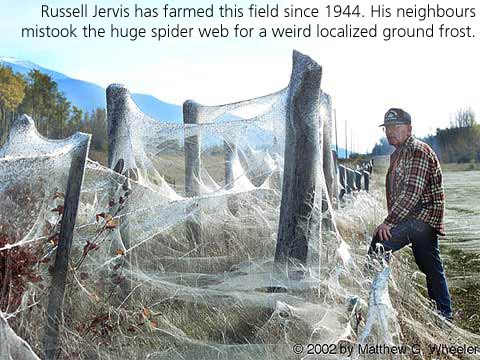
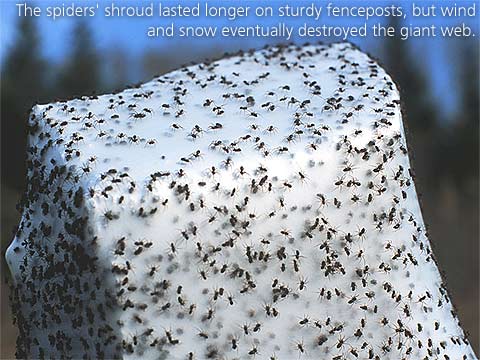


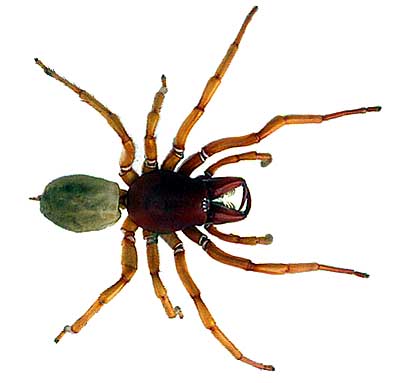


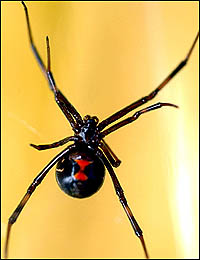


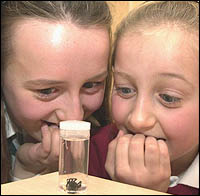
 Sam Marshall doesn’t waste much time. Seconds after stepping into the steaming rain forest of French Guiana, he
announces his agenda: "Let’s divide and search for holes with big, hairy legs." After all, he hasn’t come to French Guiana for the beaches (muddy and shark infested), the food (cheese, bread, and
sardines), or the shopping (none, but credit cards can be used to dig out ticks). He has come for the tarantulas - tarantulas that are big enough to eat birds.
Sam Marshall doesn’t waste much time. Seconds after stepping into the steaming rain forest of French Guiana, he
announces his agenda: "Let’s divide and search for holes with big, hairy legs." After all, he hasn’t come to French Guiana for the beaches (muddy and shark infested), the food (cheese, bread, and
sardines), or the shopping (none, but credit cards can be used to dig out ticks). He has come for the tarantulas - tarantulas that are big enough to eat birds.
